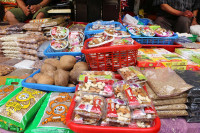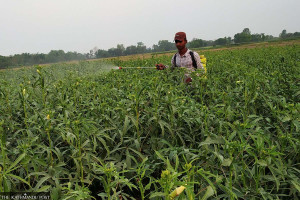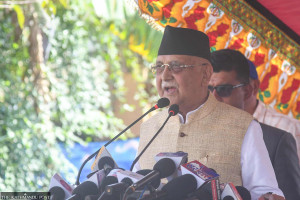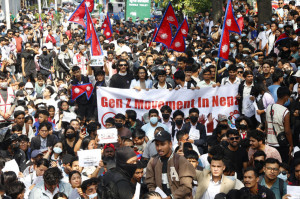Money
Bagmati top performer with economic growth rate of 6.7 percent
The province’s GDP is expected to be worth Rs1,790.68 billion in 2021-22, up from Rs1,568.41 billion a year ago.
Krishana Prasain
Bagmati province, where Nepal’s federal capital and financial hub Kathmandu is located, is expected to turn in the highest economic growth rate among the seven provinces, the Central Bureau of Statistics said on Thursday.
The government’s number cruncher says the provincial economy is likely to expand by 6.7 percent in the current fiscal year ending mid-July.
Madhes province is expected to report the slowest growth rate of 4.82 percent.
According to the province-wise gross domestic product (GDP) estimates released by the Central Bureau of Statistics, Bagmati province’s GDP is expected to be worth Rs1,790.68 billion in 2021-22, up from Rs1,568.41 billion a year ago.
Bagmati’s growth is helped by key economic activities like administrative and support services, finance and insurance, real estate and professional, and scientific and technical.
According to the bureau of statistics, Bagmati province accounts for the lion’s share of the country’s total GDP, with its contribution standing at 36.9 percent.
“The GDP of Bagmati province, which slid into negative territory two years ago due to the Covid-19 pandemic, has started improving,” said Ganesh Prasad Acharya, director of the Central Bureau of Statistics.
In 2019-20, Bagmati saw a negative growth rate of 5.69 percent. Its economy grew by 4.58 percent in the last fiscal year 2020-21.
“As most of the economic activities take place in Bagmati province, which has the highest population, it is natural that the GDP growth rate will increase,” Acharya said. “Kathmandu valley is a major importer of goods, and this weighs higher in the GDP contribution,” he said.
Gandaki province is likely to record the second highest growth rate after Bagmati with a score of 6.17 percent. Gandaki contains the tourist hotspot of Pokhara.
The output of Gandaki province is expected to reach Rs432 billion. The province’s contribution in the national GDP is expected to remain at 8.1 percent. The agriculture sector is the highest contributor to Gandaki’s GDP, accounting for 26 percent of the total.
According to the statistics, Karnali province is expected to grow by 5.5 percent in the current fiscal year, up from 4.3 percent in the last fiscal year.
The total output of Karnali in the current fiscal year is estimated to reach Rs198 billion. The share of Karnali in the total GDP is estimated to remain at 4.1 percent. The agriculture sector is a key contributor making up 31.5 percent of its GDP.
The Central Bureau of Statistics says Province 1 located in the eastern part of the country is likely to see its GDP grow by 5.41 percent to Rs763 billion in the current fiscal year. The contribution of Province 1 to the national GDP is expected reach 15.7 percent. Agriculture accounts for 33.1 percent of the GDP of Province 1.
The growth rate of Lumbini province is likely to reach 5.36 percent with its GDP amounting to Rs685 billion in the current fiscal year, the bureau said. Lumbini province accounts for 14.1 percent of the national GDP. The agriculture sector contributes 29.4 percent to the provincial GDP.
The GDP of Sudurpashchim province in the far west is estimated to grow by 4.93 percent to Rs339 billion in the current fiscal year. Its contribution to the national GDP has been estimated to remain at 7 percent. The agriculture sector is the largest contributor to its GDP with a share of 33.5 percent.
The economy of Madhes province is expected to grow at the slowest rate of 4.82 percent to Rs644 billion in the current fiscal year.
Madhes is estimated to contribute 13.3 percent to the national GDP. The agriculture sector is the highest contributor to its GDP with a share of 34.3 percent.
In the previous fiscal year 2019-20, the provincial GDP saw a negative growth rate of 2.03 percent. In the last fiscal year 2020-21, the growth rate of Madhes province recovered, reaching 3.77 percent.
Last Thursday, the Central Bureau of Statistics said in its preliminary report that the country’s economy would grow by 5.84 percent in the current fiscal year without explaining how that would happen.
Economists have questioned the optimistic economic growth data that has been released just before Nepalis go to the polls.
The official growth estimate is higher than the forecasts made by the World Bank and the Asian Development Bank. The World Bank and the Asian Development Bank have projected Nepal’s economy to grow by 3.7 percent and 3.9 percent respectively.
The government has targeted a growth rate of 7 percent.
Ishwari Prasad Bhandari, director of the Central Bureau of Statistics, said that the growth estimate is based on actual data of nine months and forecasts for the next three months.
“The three months’ estimates are based on the assumption that everything will be normal. If everything remains the same, the economic performance of all economic sectors will be the same as in a normal year.”
Bhandari says the estimate is also based on the assumption that the status of the Covid-19 pandemic will not change in the next three months, and there will be no shocks.
Computed on the basis of this growth rate, Nepal’s gross domestic product is estimated to reach Rs4.85 trillion at the end of the fiscal year in mid-July.




 16.12°C Kathmandu
16.12°C Kathmandu















